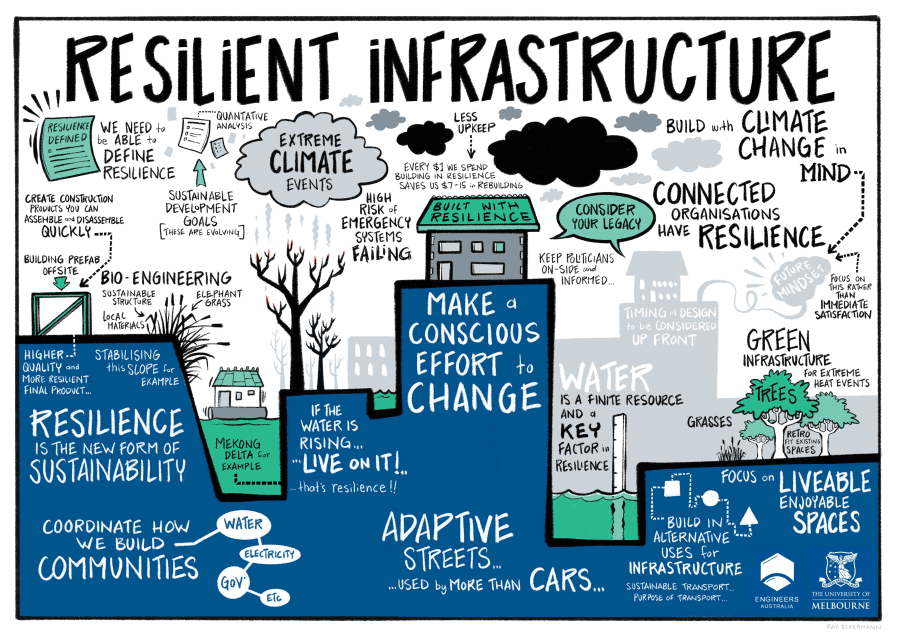What Are The Considerations For Designing Resilient Infrastructure?

Building climate resilient infrastructure is one of the most important tasks of our time. With the changing climate conditions, it is important that we develop infrastructure that can withstand the impacts of natural disasters and other climate-related events. In this thought leaders series, we will be discussing the various aspects of building climate resilient infrastructure and what steps we can take to achieve this goal.
What is climate resilient infrastructure?
Climate resilient infrastructure is infrastructure that is designed to withstand the impacts of climate change. This includes infrastructure that is able to withstand natural disasters such as floods, droughts, and storms. It also includes infrastructure that is able to adapt to changing climate conditions such as rising sea levels, higher temperatures, and changes in precipitation patterns.
Why is it important to build climate resilient infrastructure?
Building climate resilient infrastructure is important for a number of reasons. Firstly, it can help to reduce the impact of natural disasters and other climate-related events. This can save lives and reduce the damage to property and infrastructure. Secondly, it can help to reduce the costs associated with repairing and rebuilding infrastructure after these events. Finally, it can help to ensure that infrastructure is able to continue to function in a changing climate, reducing the risks of disruptions to essential services such as water and power.
How can we build climate resilient infrastructure?
There are a number of steps that we can take to build climate resilient infrastructure. These include:
1. Conducting a climate risk assessment
Before building new infrastructure or upgrading existing infrastructure, it is important to conduct a climate risk assessment. This can help to identify the risks of climate-related events such as floods, droughts, and storms. It can also help to identify areas where infrastructure may be vulnerable to these events.
2. Incorporating climate resilience into design and planning
Once the risks have been identified, it is important to incorporate climate resilience into the design and planning of infrastructure projects. This can involve a range of measures such as designing buildings and infrastructure to withstand extreme weather events, incorporating green infrastructure such as rain gardens and tree-lined streets, and designing infrastructure to be flexible and adaptable to changing climate conditions.
3. Ensuring maintenance and monitoring of infrastructure
Infrastructure that is not maintained properly may be more vulnerable to climate-related events. It is important to ensure that infrastructure is well-maintained and that regular monitoring is conducted to identify any vulnerabilities and to ensure that the infrastructure remains resilient in the face of changing climate conditions.
4. Engaging with the community
Building climate resilient infrastructure requires the engagement of the community. This can involve consulting with the community to identify their concerns and priorities, educating the community about the risks of climate-related events, and involving the community in the design and planning of infrastructure projects.
FAQ
What are some examples of climate resilient infrastructure?
Examples of climate resilient infrastructure include buildings that are designed to withstand extreme weather events, green infrastructure such as rain gardens and tree-lined streets, and infrastructure that is flexible and adaptable to changing climate conditions.
How much does it cost to build climate resilient infrastructure?
The cost of building climate resilient infrastructure can vary depending on a range of factors such as the type of infrastructure, the location, and the climate risks. However, it is generally agreed that the cost of building climate resilient infrastructure is much lower than the cost of repairing and rebuilding infrastructure after a natural disaster or other climate-related event.
What role can governments play in building climate resilient infrastructure?
Governments can play a key role in building climate resilient infrastructure. This can involve providing funding for infrastructure projects, developing policies and regulations that encourage the development of climate resilient infrastructure, and providing guidance and support to communities and businesses to help them build climate resilient infrastructure.
What can individuals do to support the development of climate resilient infrastructure?
Individuals can play a role in supporting the development of climate resilient infrastructure. This can involve using public transport and active transport options such as walking and cycling, reducing energy consumption in their homes and businesses, and supporting policies and regulations that encourage the development of climate resilient infrastructure.
In conclusion, building climate resilient infrastructure is one of the most important tasks of our time. It is important that we take action now to ensure that our communities and infrastructure are able to withstand the impacts of natural disasters and other climate-related events. By conducting climate risk assessments, incorporating climate resilience into design and planning, ensuring maintenance and monitoring, and engaging with the community, we can help to build infrastructure that is able to withstand the challenges posed by a changing climate.




Post a Comment for "What Are The Considerations For Designing Resilient Infrastructure?"